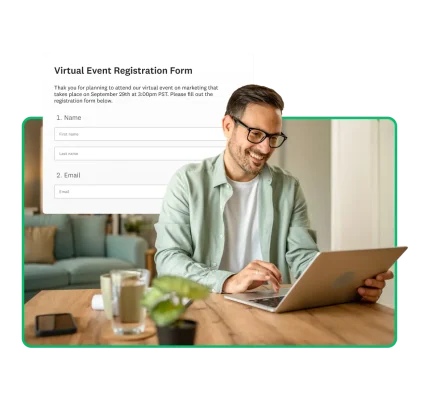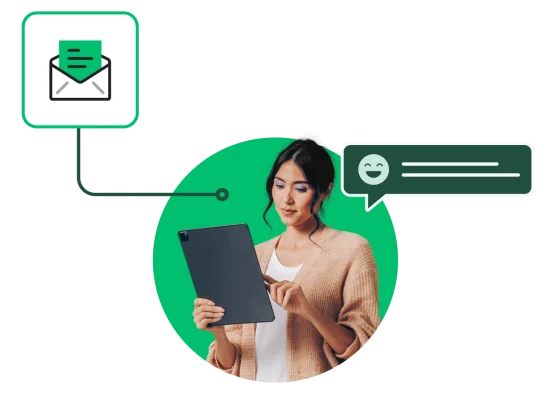Best practices for collecting feedback on virtual events
Use surveys to receive helpful feedback and maximize your virtual events.

- Virtual event feedback surveys are instrumental in creating engaging events that drive audience satisfaction.
- Timing, length, and accessibility are crucial to attaining a high post-event survey response rate.
- A good post-event survey uses open- and close-ended questions to gain qualitative and quantitative data.
The number of virtual events skyrocketed during the pandemic and has remained strong ever since. To make the most of these virtual events, organizations should ask for post-virtual event feedback.
Event feedback provides insight into the event’s success and ideas for improvement. By incorporating feedback, you can improve future events and increase audience satisfaction.
Let’s explore how to use virtual event surveys to encourage high response rates.
Virtual event feedback survey best practices

Virtual event feedback surveys give your business insight into the success of your events. These surveys guide future events, helping you understand how to create more stimulating conferences.
Consider implementing the following best practices to get the most from your virtual event feedback surveys.
Be aware of survey timing
The phrase “timing is everything” holds for event feedback surveys. Sending a survey weeks after an event is less than ideal. Delayed surveys will hamper response rates and negatively impact the quality of feedback as participant memories fade.
Conversely, sending a survey before the event finishes is rash. Participants can’t provide meaningful feedback if they haven’t completed the session. They may also forget to complete the survey after the event.
The best approach is to send the survey immediately after the virtual event when the session is fresh in participants’ minds. This timing can increase response rates and help you get robust feedback and data.
For more timing information, check out 5 ways to time and send your surveys for better results.
Provide context
In your post-event communication, you can reinforce key points from the event to refresh participants’ memory. This can provide context for the survey and improve the quality of responses.
Some examples of good content to include could be:
- A summary of the event
- The top 3 takeaways that you want participants to remember
- A brief video clip from the event that reinforces key information
- Charts, graphs, slides, or other visuals from the event
This information encourages specific and detailed responses. For example, providing a graph may inspire people to leave feedback on its effectiveness.
Looking for an easy way to boost survey response rates and provide context? Embed your first survey question in your email invite. By weaving your first question into your survey invitation, you can boost response rates by as much as 22%. This approach offers an easy entry point for recipients to start the survey, increasing the chances that they will finish it.
Related reading: Post-event feedback survey template.
Consider survey length
After attending a virtual event, the last thing people will want to do is fill out a lengthy survey. Keep your surveys short and sweet.
A clear and concise survey will likely get a strong response. Consider the number of questions in your survey and the length of the questions. Is each question preceded by a paragraph that the respondent needs to read? Are you asking several open-ended questions in a row?
If possible, get feedback from your team to ensure the survey questions are concise and elicit actionable information.
Send mobile-friendly surveys
To ensure a high response rate, make your survey accessible.
A mobile-friendly survey allows participants to complete the survey immediately after the event. Busy participants don’t need access to a laptop and may be more likely to complete the survey.
Distribute surveys via email
Sending your survey via email is one of the most effective ways to distribute surveys to participants.
Email survey distribution has many advantages. For starters, respondents likely expect post-event communications to be sent to the email they registered with. As you already have an email list from registrations, sending the survey is fast, easy, and effective.
With SurveyMonkey, you can also personalize each email by first name and track open and click-through rates.
Follow up with survey reminders
While many event attendees may immediately provide feedback, others may forget or overlook the survey email. Instead of accepting a lower response rate, you can send a gentle reminder.
You can rapidly follow up by tracking whether attendees on your event mailing list responded to your survey. The ease of sending reminders is another reason why email distribution is advantageous.
However, it’s important not to go overboard with reminders, as recipients may associate them with spam. A good practice is to send a reminder a few days after the initial email and follow up about five days later with a final reminder.
Thank attendees for participating
A little gratitude can go a long way. By thanking your participants for attending the event, you give them more reasons to take time to provide you with feedback.
Sending a message to attendees after the event is a great way to show them that you appreciate their attendance and participation. Additionally, you can use this space to include links to feedback surveys, creating a direct CTA for people to provide feedback.
If someone gives you feedback, you should also thank them and outline steps you’ll take to improve based on their response.
Related reading: 4 tips for throwing a polished business event… even if you’re not a pro.
Types of virtual event surveys
There are several types of virtual event surveys that you can use to collect information after your event. Here are some of the most common types of virtual event surveys.
General event surveys
General event surveys aim to measure the success of a virtual event. The type of questions in a general event survey relates to an audience member’s perception of the event.
Here are a few typical questions you can use in a general event survey:
- How would you rate the event on a scale of 1-10?
- Was the event too long, too short, or about right?
- How likely are you to recommend this event to a colleague?
Our general event feedback survey template includes these questions and more. This template will help you learn how attendants perceive your event’s organizational details.
Professional event surveys
Professional event surveys aim to gather feedback after a work-related event. With this survey, you can learn participant takeaways and pain points. These surveys are more formal than general event surveys.
Here are some typical questions you can use in a professional event survey:
- On a scale of 1-10, how relevant was the event's content to your profession?
- How likely are you to recommend the event to a colleague?
- Would you attend a similar event in the future?
These questions are designed to determine whether the professional event succeeded and how to deliver a better experience.
Event planning surveys
Event planning surveys are pre-event surveys that help you plan future events. They seek to understand attendees' expectations of event details, like session arrangements.
Here are some typical questions you can use in an event planning survey:
- Do you plan on attending the [event] on [date]?
- What topics would you like to explore at the event?
- How long do you think the event should take?
Using surveys before your event can help you perfect logistics, schedule sessions, and gauge attendance.
Related reading: Event feedback survey template
Types of survey questions
The types of survey questions you include in your virtual event survey should be driven by your survey objective. Depending on the ideal feedback you want to receive, you may opt for closed-ended questions, open-ended questions, or a mix of the two.
Close-ended questions
Close-ended questions are any questions with a limited number of potential answers. The most simple close-ended question is a yes-no question. However, multiple-choice questions and rating scale questions also fall into this category.
You can use closed-ended questions in a survey to collect quantitative data. For example, you could ask attendees to rate how likely they are to recommend the event to a colleague on a scale of 1-10. All the responses will fall somewhere on this scale, allowing you to determine the event’s reception quickly.
Multiple-choice question
A multiple-choice question offers survey respondents several fixed-answer options. The answers cover the possible opinions someone could have in response to the question. Respondents can then select the answer that most closely aligns with their opinion.
Multiple-choice questions are useful because the answers are structured and can be easily analyzed. In addition, these questions are common, meaning respondents may have experience interacting with them.
Here’s an example of a multiple-choice question:
“Which of the speaker events did you find most insightful into [topic]?”
- Speaker one
- Speaker two
- Speaker three
Rating scale question
A rating scale question asks respondents to select on a scale how much they agree with a statement. Every number option on the scale represents a different sentiment. For example, a 1 on a 1-5 scale could represent strongly disagree, while 5 could represent strongly agree.
Rating scale questions offer a highly structured way for respondents to give their opinions. There is a degree of flexibility, as respondents can choose from a range of answers, but their answers fall into neat categories for analysis.
Here’s an example of a rating scale question:
“On a scale of 1-10, how likely are you to recommend this virtual event to a colleague?
Yes or no question
A yes or no question gives respondents two choices, often disagreeing or agreeing with a specific statement. While they can be effective alone, yes or no questions are usually best paired with a follow-up open-ended question to understand someone’s opinion behind their yes or no.
Yes or no questions are great because they’re extremely quick to answer and provide data that is easy to analyze for your business. They can also serve as qualifying questions, where a positive or negative response leads the respondent to different question pathways.
Here’s an example of a yes or no question:
“Did you attend the virtual event on [topic] on [date]?”
Likert scale question
The Likert scale offers five to seven answers representing someone’s attitudes toward a certain question. It helps categorize respondents on a scale from one extreme to another.
This question scale is useful as it provides highly quantifiable data on someone’s attitudes and opinions. Like other closed-ended questions, Likert scale questions may benefit from additional open-ended questions to collect further insight into someone’s opinion.
Here’s an example of a Likert scale question:
“How easy or difficult was signing up for our virtual event?”
- Very difficult.
- Somewhat difficult.
- Neither difficult nor easy.
- Somewhat easy.
- Very easy.
Related reading: 15 post-event survey questions to ask at your next event.
Open-ended questions
Open-ended questions aim to capture respondents’ opinions, feelings, and experiences in their own words. The constructive feedback you receive from these questions is more detailed and laced with insights that can be extremely useful in assessing the success of the event, what hit the mark, and ways to improve.
Be selective when including open-ended questions in a virtual event survey. Respondents should see them as reasonable and worthwhile to answer. Open-ended questions take longer to respond to, meaning you should only include a few in your survey.
One smart approach is to present several closed-ended questions and then wrap the survey up with an open-ended question such as “What suggestions do you have to improve future virtual events?” This will provide more in-depth insights from your respondents and allow them to share suggestions not covered in earlier closed-ended questions.
Virtual event survey questions

Virtual event survey questions can look very similar to in-person event questions, but be sure to gauge engagement in the virtual environment.
Here’s a list of questions you can use in a virtual event feedback survey to determine your event's success.
Did you attend the virtual event, and if not, why?
This question is a yes or no question followed by an open-answer question. Opening your virtual event survey with this will act as a gate to allow people who attended the event to answer further questions and prevent non-attendees from interacting with post-event questions.
You can also use this question to determine whether a limiting factor prevented some people from attending your event.
Overall, how would you rate this virtual event?
This question stems from the Likert scale and allows you to understand your event's success. Respondents will choose on a scale of “Extremely likely” to “Extremely unlikely,” with between five and seven total options.
This style of question reflects the Net Promoter Score® (NPS) question and will help you better understand whether people enjoyed your event enough to recommend it to a friend.
Is there anything you disliked about the event?
An open-ended question allows respondents to freely share their opinions. This question will help you identify potential issues with your event, which you can smooth out for the next time.
How can we improve for future events?
This form of open-ended question aims to identify improvements you can make for next time. As an open-ended question, respondents could give feedback on any area of your virtual event, ranging from the speakers and content to the platform used.
Was the virtual event set up in an easy-to-use way?
A quick yes-no question related to the technology you used to share your virtual event will help you easily understand whether you should keep using it or switch it up. You are looking for a high proportion of positive responses to this question. Consider looking into other tech platforms if you receive a fair share of yeses and nos.
How would you rate the platform?
Following a rating scale question, this open-ended question will provide further context to the previous yes or no question. Adding this question allows people to give a broader answer, allowing you to quantify how effective the platform was on a scale of 1-10.
How was your experience with the virtual presenters?
Open-ended questions can target specific aspects of the event to generate insight. This question will collect feedback on your virtual presenters and help you decide whether or not they gave an effective and engaging presentation. The open-ended nature of the question will also provide insight into which areas a presentation excelled at or could improve in.
Do you think this virtual event was too long, too short, or about right?
A multiple-choice question about your virtual event can give you specific insight into how the audience perceived the session. The question above will help you identify whether you need to extend, reduce, or keep the virtual event the same length in the future.
How well did this virtual event meet your expectations?
Depending on the specific insight you want to gain from this question, you could use the Likert scale, a multiple-choice system, or even a ranking scale. Whichever you choose, this question will give you an overview of how successful the event was and how satisfied your attendees were with it. Low scores could suggest you have some improvements to make, while high scores suggest that you are running a great virtual event.
Is there any other feedback you’d like to share?
Finishing with an open-ended question is always a good idea, as it allows people to leave any final comments, concerns, or suggestions that haven’t been addressed in your survey thus far. This will collect further information that can provide additional context to help you refine your event in the future.
Frequently asked questions
How do you gather event feedback?
The best way to gather event feedback is to send out post-event surveys. Surveys provide an accessible and quick method for attendees to leave feedback for the organizers.
What are good questions to ask for event feedback?
The best questions to ask for event feedback will cover the event on several different levels. Start by asking whether the attendee was satisfied with the event as a whole before moving on to more granular questions about different aspects. For example, you could touch on whether the presenters were effective or if the virtual platform worked as intended.
How many questions should a feedback survey have?
A feedback survey should be short and to the point, as attendees won’t want to spend lots of time filling out a long post-event survey. Where possible, keep the survey under 10 questions, with most of those being quick-to-answer, closed-ended questions.
Improve your virtual event management with SurveyMonkey
Virtual event surveys are extremely effective for gathering feedback after an event. By collecting, acting, and using audience feedback, you can improve your virtual events, creating more interesting and engaging events in the future.
With SurveyMonkey, you can rapidly create and deploy post-event surveys. With just a few clicks, you can send highly personalized post-event surveys to your attendees, making it as easy for them to leave feedback.
Sign up for free today to get started.
Net Promoter, Net Promoter Score, and NPS are trademarks of Satmetrix Systems, Inc., Bain & Company, Inc., and Fred Reichheld.
Discover more resources

Understand your target market to fuel explosive brand growth
Brand marketing managers can use this toolkit to understand your target audience, grow your brand, and prove ROI.

Customer Behavior Analysis: A Complete Guide and Examples
Read our step-by-step guide on conducting customer behavior analysis. Learn how to collect data and improve customer touchpoints.

Survey Analysis Report: How to Create, Tips & Examples
Presenting your research soon? Learn the most effective way to use a survey analysis report. See sections to include and report best practices.

What is agile market research and how to use it
Conduct market research faster for real-time insights and smart decision-making. Learn what agile market research is and how to apply the framework.